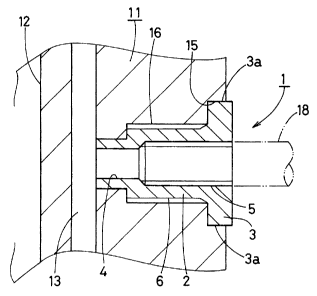Une partie des informations de ce site Web a été fournie par des sources externes. Le gouvernement du Canada n'assume aucune responsabilité concernant la précision, l'actualité ou la fiabilité des informations fournies par les sources externes. Les utilisateurs qui désirent employer cette information devraient consulter directement la source des informations. Le contenu fourni par les sources externes n'est pas assujetti aux exigences sur les langues officielles, la protection des renseignements personnels et l'accessibilité.
L'apparition de différences dans le texte et l'image des Revendications et de l'Abrégé dépend du moment auquel le document est publié. Les textes des Revendications et de l'Abrégé sont affichés :
| (12) Brevet: | (11) CA 2475483 |
|---|---|
| (54) Titre français: | VIS D'ASSEMBLAGE DE TUBE D'ALIMENTATION DE GAZ POUR BUSE DE COULEE EN CONTINU |
| (54) Titre anglais: | GAS FEED PIPE CONNECTING SCREW FOR CONTINUOUS CASTING NOZZLE |
| Statut: | Réputé périmé |
| (51) Classification internationale des brevets (CIB): |
|
|---|---|
| (72) Inventeurs : |
|
| (73) Titulaires : |
|
| (71) Demandeurs : |
|
| (74) Agent: | OSLER, HOSKIN & HARCOURT LLP |
| (74) Co-agent: | |
| (45) Délivré: | 2010-02-02 |
| (22) Date de dépôt: | 2004-07-22 |
| (41) Mise à la disponibilité du public: | 2005-02-05 |
| Requête d'examen: | 2006-07-10 |
| Licence disponible: | S.O. |
| (25) Langue des documents déposés: | Anglais |
| Traité de coopération en matière de brevets (PCT): | Non |
|---|
| (30) Données de priorité de la demande: | ||||||
|---|---|---|---|---|---|---|
|
L'invention concerne une vis d'assemblage de tube d'alimentation de gaz pour buse de coulée en continu. La vis est montée sur la buse de coulée continue formée avec une fente en forme d'anneau s'étendant axialement et sensiblement concentrique avec un alésage de buse. La vis relie à la buse un tuyau d'alimentation en gaz qui souffle un gaz dans la fente. La vis comprend un corps de vis ayant un orifice d'alimentation en gaz formé sensiblement à travers sa partie centrale, une bride fixée à un trou de montage formé dans une paroi latérale de la buse de coulée continue, un filetage mâle à mettre en prise avec un premier filetage femelle formé dans le trou de montage, et un deuxième filetage femelle formé dans l'orifice d'alimentation en gaz pour assurer la connexion du tuyau d'alimentation en gaz. La bride comporte un coin de cran qui entre en prise avec le mortier qui remplit le trou de montage après avoir été inséré dans le trou de montage.
A gas feed pipe connecting screw for a continuous casting nozzle is disclosed. The screw is mounted to the continuous casting nozzle formed with an axially extending ring-shaped slit substantially concentric with a nozzle bore. The screw connects to the nozzle a gas feed pipe blowing a gas into the slit. The screw includes a screw body having a gas feed hole formed through substantially its central portion, a flange fitted into a mounting hole formed in a side wall of the continuous casting nozzle, a male thread engaging a first female thread formed in the mounting hole, and a second female thread formed in the gas feed hole for connection of the gas feed pipe. The flange has a detent corner engaging mortar filling the mounting hole after having been fitted into the mounting hole.
Note : Les revendications sont présentées dans la langue officielle dans laquelle elles ont été soumises.
Note : Les descriptions sont présentées dans la langue officielle dans laquelle elles ont été soumises.

Pour une meilleure compréhension de l'état de la demande ou brevet qui figure sur cette page, la rubrique Mise en garde , et les descriptions de Brevet , États administratifs , Taxes périodiques et Historique des paiements devraient être consultées.
| Titre | Date |
|---|---|
| Date de délivrance prévu | 2010-02-02 |
| (22) Dépôt | 2004-07-22 |
| (41) Mise à la disponibilité du public | 2005-02-05 |
| Requête d'examen | 2006-07-10 |
| (45) Délivré | 2010-02-02 |
| Réputé périmé | 2016-07-22 |
Il n'y a pas d'historique d'abandonnement
| Type de taxes | Anniversaire | Échéance | Montant payé | Date payée |
|---|---|---|---|---|
| Le dépôt d'une demande de brevet | 400,00 $ | 2004-07-22 | ||
| Enregistrement de documents | 100,00 $ | 2004-11-12 | ||
| Requête d'examen | 800,00 $ | 2006-07-10 | ||
| Taxe de maintien en état - Demande - nouvelle loi | 2 | 2006-07-24 | 100,00 $ | 2006-07-10 |
| Taxe de maintien en état - Demande - nouvelle loi | 3 | 2007-07-23 | 100,00 $ | 2007-07-18 |
| Taxe de maintien en état - Demande - nouvelle loi | 4 | 2008-07-22 | 100,00 $ | 2008-07-17 |
| Taxe de maintien en état - Demande - nouvelle loi | 5 | 2009-07-22 | 200,00 $ | 2009-06-09 |
| Taxe finale | 300,00 $ | 2009-11-06 | ||
| Taxe de maintien en état - brevet - nouvelle loi | 6 | 2010-07-22 | 200,00 $ | 2010-07-21 |
| Taxe de maintien en état - brevet - nouvelle loi | 7 | 2011-07-22 | 200,00 $ | 2011-05-16 |
| Taxe de maintien en état - brevet - nouvelle loi | 8 | 2012-07-23 | 200,00 $ | 2012-06-14 |
| Taxe de maintien en état - brevet - nouvelle loi | 9 | 2013-07-22 | 200,00 $ | 2013-04-25 |
| Taxe de maintien en état - brevet - nouvelle loi | 10 | 2014-07-22 | 250,00 $ | 2014-07-16 |
Les titulaires actuels et antérieures au dossier sont affichés en ordre alphabétique.
| Titulaires actuels au dossier |
|---|
| AKECHI CERAMICS KABUSHIKI KAISHA |
| Titulaires antérieures au dossier |
|---|
| NAITO, SYOJIRO |
| UCHIDA, KAZUHIDE |